Which of the Following Would Most Likely Require a Complete Review of Systems
Fever is elevated body temperature (> 37.8° C orally or > 38.2° C rectally) or an elevation above a person'southward known normal daily value. Fever occurs when the body'southward thermostat (located in the hypothalamus) resets at a higher temperature, primarily in response to an infection. Elevated trunk temperature that is not caused by a resetting of the temperature set point is called hyperthermia.
Many patients use "fever" very loosely, often meaning that they feel also warm, likewise cold, or sweaty, but they have non actually measured their temperature.
Symptoms are due mainly to the condition causing the fever, although fever itself can cause chills, sweats, and discomfort and make patients experience flushed and warm.
During a 24-hr catamenia, temperature varies from lowest levels in the early morning to highest in late afternoon. Maximum variation is nearly 0.half-dozen° C.
Body temperature is determined past the residuum between heat production by tissues, peculiarly the liver and muscles, and heat loss from the periphery. Normally, the hypothalamic thermoregulatory center maintains the internal temperature between 37° and 38° C. Fever results when something raises the hypothalamic set point, triggering vasoconstriction and shunting of blood from the periphery to decrease heat loss; sometimes shivering, which increases heat production, is induced. These processes proceed until the temperature of the blood bathing the hypothalamus reaches the new set point. Resetting the hypothalamic gear up betoken downward (eg, with antipyretic drugs) initiates heat loss through sweating and vasodilation.
The capacity to generate a fever is reduced in certain patients (eg, alcoholics, the very old, the very young).
Pyrogens are substances that cause fever. Exogenous pyrogens are usually microbes or their products. The best studied are the lipopolysaccharides of gram-negative leaner (usually called endotoxins) and Staphylococcus aureus toxin, which causes toxic shock syndrome. Fever is the result of exogenous pyrogens that induce release of endogenous pyrogens, such as interleukin-1 (IL-1), tumor necrosis factor-blastoff (TNF-alpha), and IL-six and other cytokines, which then trigger cytokine receptors, or of exogenous pyrogens that directly trigger Toll-like receptors.
Prostaglandin E2 synthesis appears to play a critical role.
Although many patients worry that fever itself can cause harm, the modest transient core temperature elevations (ie, 38 to twoscore° C) caused by most acute infections are well tolerated by good for you adults.
Nonetheless, farthermost temperature elevation (typically > 41° C) may be dissentious. Such elevation is more typical of severe environmental hyperthermia but sometimes results from exposure to illicit drugs (eg, cocaine, phencyclidine), anesthetics, or antipsychotic drugs. At this temperature, protein denaturation occurs, and inflammatory cytokines that activate the inflammatory cascade are released. As a result, cellular dysfunction occurs, leading to malfunction and ultimately failure of most organs; the coagulation cascade is likewise activated, leading to disseminated intravascular coagulation Disseminated Intravascular Coagulation (DIC) Disseminated intravascular coagulation (DIC) involves abnormal, excessive generation of thrombin and fibrin in the circulating blood. During the process, increased platelet assemblage and coagulation... read more than (DIC).
Because fever tin can increase the basal metabolic rate by about x to 12% for every 1° C increase over 37° C, fever may physiologically stress adults with preexisting cardiac or pulmonary insufficiency. Fever can also worsen mental status in patients with dementia.
Many disorders tin can cause fever. They are broadly categorized every bit
-
Infectious (near common)
-
Neoplastic
-
Inflammatory (including rheumatic, nonrheumatic, and drug-related)
The cause of an astute (ie, elapsing ≤ iv days) fever in adults is highly likely to be infectious. When patients present with fever due to a noninfectious cause, the fever is almost always chronic or recurrent. Also, an isolated, acute febrile event in patients with a known inflammatory or neoplastic disorder is notwithstanding almost likely to be infectious. In good for you people, an acute febrile issue is unlikely to be the initial manifestation of a chronic disease.
Virtually all infectious illnesses can crusade fever. But overall, the most likely causes are
-
Upper and lower respiratory tract infections
-
Gastrointestinal infections
-
Skin infections
Most acute respiratory tract and gastrointestinal infections are viral.
Specific patient and external factors also influence which causes are most likely.
Patient factors include health condition, historic period, occupation, and risk factors (eg, hospitalization, recent invasive procedures, presence of IV or urinary catheters, use of mechanical ventilation).
External factors are those that expose patients to specific diseases—eg, through infected contacts, local outbreaks, disease vectors (eg, mosquitoes, ticks), a common vehicle (eg, food, h2o), or geographic location (eg, residence in or contempo travel to an endemic area).
Two full general bug are important in the initial evaluation of acute fever:
-
Identifying whatever localizing symptoms (eg, headache, coughing): These symptoms help narrow the range of possible causes. The localizing symptom may be part of the patient's chief complaint or identified simply past specific questioning.
-
Determining whether the patient is seriously or chronically ill (particularly if such illness is unrecognized): Many causes of fever in salubrious people are self-express, and many of the possible viral infections are hard to diagnose specifically. Limiting testing to the seriously or chronically ill can assist avoid many expensive, unnecessary, and frequently fruitless searches.
History of present disease should encompass magnitude and duration of fever and method used to accept the temperature. Truthful rigors (severe, shaking, teeth-chattering chills—not simply feeling cold) suggest fever due to infection but are not otherwise specific. Pain is an of import clue to the possible source; the patient should be asked about hurting in the ears, head, cervix, teeth, pharynx, chest, belly, flank, rectum, muscles, and joints.
Other localizing symptoms include nasal congestion and/or discharge, cough, diarrhea, and urinary symptoms (frequency, urgency, dysuria). Presence of rash (including nature, location, and time of onset in relation to other symptoms) and lymphadenopathy may aid.
Infected contacts and their diagnosis should be identified.
Review of systems should identify symptoms of chronic illness, including recurrent fevers, night sweats, and weight loss.
By medical history should particularly cover the following:
-
Recent surgery
-
Known conditions that predispose to infection (eg, HIV infection, diabetes, cancer, organ transplantation, sickle prison cell affliction, valvular centre disorders—particularly if an artificial valve is present)
-
Other known disorders that predispose to fever (eg, rheumatologic disorders, systemic lupus erythematosus, gout, sarcoidosis, hyperthyroidism, cancer)
Questions to ask about recent travel include location, time since return, locale (eg, in dorsum state, simply in cities), vaccinations received before travel, and any use of prophylactic antimalarial drugs (if required).
All patients should exist asked nigh possible exposures. Examples include unsafe nutrient (eg, unpasteurized milk and milk products, raw or undercooked meat, fish, shellfish) or h2o, insect bites (eg, history of tick, mosquito, or other arthropod vector exposure), creature contact, unprotected sex, and occupational or recreational exposures (eg, hunting, hiking, water sports).
Vaccination history, specially against hepatitis A and B and against organisms that crusade meningitis, influenza, or pneumococcal infection, should exist noted.
Drug history should include specific questions about the following:
-
Drugs that predispose to increased take a chance of infection (eg, corticosteroids, anti-tumor necrosis factor drugs, chemotherapeutic and antirejection drugs, other immunosuppressants)
-
Illicit use of injection drugs (predisposing to endocarditis, hepatitis, septic pulmonary emboli, and skin and soft-tissue infections)
Physical exam begins with confirmation of fever. Fever is most accurately diagnosed by measuring rectal temperature. Oral temperatures are normally about 0.half dozen° C lower and may be falsely even lower for many reasons, such as recent ingestion of a cold drink, mouth breathing, hyperventilation, and inadequate measurement time (up to several minutes are required with mercury thermometers). Measurement of tympanic membrane temperature by infrared sensor is less authentic than rectal temperature. Monitoring skin temperature using temperature-sensitive crystals incorporated into plastic strips placed on the forehead is insensitive for detecting elevations in the cadre temperature. During the COVID-xix pandemic, use of infrared devices to measure skin temperature (eg, of the forehead) to screen people for fever prior to entry in public places has go mutual.
Other vital signs are reviewed for presence of tachypnea, tachycardia, or hypotension.
For patients with localizing symptoms, exam gain as discussed elsewhere in THE MANUAL. For delirious patients without localizing symptoms, a complete examination is necessary because clues to the diagnosis may be in whatever organ organization.
The patient's general appearance, including any weakness, lethargy, confusion, cachexia, and distress, should exist noted.
All of the skin should be inspected for rash, particularly petechial or hemorrhagic rash and any lesions (eg, eschar) or areas of erythema or blistering suggesting skin or soft-tissue infection. Neck, axillae, and epitrochlear and inguinal areas should be examined for adenopathy.
In hospitalized patients, presence of whatsoever IVs, nasogastric tubes, urinary catheters, and any other tubes or lines inserted into the body should be noted. If patients have had contempo surgery, surgical sites should exist thoroughly inspected.
For the caput and neck examination, the following should be done:
-
Tympanic membranes: Examined for infection
-
Sinuses (frontal and maxillary): Percussed
-
Temporal arteries: Palpated for tenderness
-
Nose: Inspected for congestion and discharge (clear or purulent)
-
Eyes: Inspected for conjunctivitis or icterus
-
Fundi: Inspected for Roth spots (suggesting endocarditis)
-
Oropharynx and gingiva: Inspected for inflammation or ulceration (including any lesions of candidiasis, which suggests immunocompromise)
-
Neck: Flexed to find discomfort, stiffness, or both, indicating meningismus, and palpated for adenopathy
The lungs are examined for crackles or signs of consolidation, and the eye is auscultated for murmurs (suggesting possible endocarditis).
The abdomen is palpated for hepatosplenomegaly and tenderness (suggesting infection).
The flanks are percussed for tenderness over the kidneys (suggesting pyelonephritis).
A pelvic examination is washed in women to check for cervical motility or adnexal tenderness; a genital test is done in men to cheque for urethral discharge and local tenderness.
The rectum is examined for tenderness and swelling, suggesting perirectal abscess (which may exist occult in immunosuppressed patients).
All major joints are examined for swelling, erythema, and tenderness (suggesting a joint infection or rheumatologic disorder). The hands and feet are inspected for signs of endocarditis, including splinter hemorrhages under the nails, painful erythematous subcutaneous nodules on the tips of digits (Osler nodes), and nontender hemorrhagic macules on the palms or soles (Janeway lesions).
The spine is percussed for focal tenderness.
The post-obit findings are of particular concern:
-
Contradistinct mental status
-
Headache, strong neck, or both
-
Petechial rash
-
Hypotension
-
Dyspnea
-
Significant tachycardia or tachypnea
-
Temperature > 40° C or < 35° C
-
Recent travel to an expanse where serious diseases (eg, malaria) are endemic
-
Recent use of immunosuppressants
The degree of pinnacle in temperature usually does non predict the likelihood or cause of infection. Fever pattern, once idea to be pregnant, rarely is helpful with the possible exceptions of tertian and quartan malaria Malaria Malaria is infection with Plasmodium species. Symptoms and signs include fever (which may be periodic), chills, rigors, sweating, diarrhea, intestinal pain, respiratory distress, confusion... read more and relapsing episodes (eg, brucellosis Brucellosis Brucellosis is acquired by Brucella species, which are gram-negative bacteria. Symptoms begin as an acute febrile illness with few or no localized signs and may progress to a chronic stage... read more than ).
Likelihood of serious disease is considered. If serious illness is suspected, immediate and ambitious testing and often hospital access are needed.
Red flag findings strongly suggest a serious disorder, as in the post-obit:
Immunocompromise, whether caused by a known disorder or use of immunosuppressants or suggested past examination findings (eg, weight loss, oral candidiasis), is also of concern, as are other known chronic illnesses, injection drug employ, and heart murmur.
Localizing findings identified by history or physical test are evaluated and interpreted (come across elsewhere in THE MANUAL). Other suggestive findings include generalized adenopathy and rash.
Generalized adenopathy may occur in older children and younger adults who have acute mononucleosis Infectious Mononucleosis Infectious mononucleosis is caused by Epstein-Barr virus (EBV, human herpesvirus type 4) and is characterized past fatigue, fever, pharyngitis, and lymphadenopathy. Fatigue may persist weeks or... read more 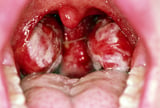 ; it is usually accompanied by significant pharyngitis, malaise, and hepatosplenomegaly. Primary HIV infection Human being Immunodeficiency Virus (HIV) Infection Man immunodeficiency virus (HIV) infection results from ane of 2 similar retroviruses (HIV-ane and HIV-2) that destroy CD4+ lymphocytes and impair cell-mediated immunity, increasing risk of sure... read more
; it is usually accompanied by significant pharyngitis, malaise, and hepatosplenomegaly. Primary HIV infection Human being Immunodeficiency Virus (HIV) Infection Man immunodeficiency virus (HIV) infection results from ane of 2 similar retroviruses (HIV-ane and HIV-2) that destroy CD4+ lymphocytes and impair cell-mediated immunity, increasing risk of sure... read more  or secondary syphilis Syphilis Syphilis is caused by the spirochete Treponema pallidum and is characterized past 3 sequential clinical, symptomatic stages separated by periods of asymptomatic latent infection. Common... read more
or secondary syphilis Syphilis Syphilis is caused by the spirochete Treponema pallidum and is characterized past 3 sequential clinical, symptomatic stages separated by periods of asymptomatic latent infection. Common... read more  should be suspected in patients with generalized adenopathy, sometimes accompanied by arthralgias, rash, or both. HIV infection develops 2 to 6 weeks after exposure (although patients may not always report unprotected sexual contact or other gamble factors). Secondary syphilis is usually preceded by a chancre, with systemic symptoms developing 4 to 10 weeks after. Even so, patients may non notice a chancre because information technology is painless and may be located out of sight in the rectum, vagina, or oral crenel.
should be suspected in patients with generalized adenopathy, sometimes accompanied by arthralgias, rash, or both. HIV infection develops 2 to 6 weeks after exposure (although patients may not always report unprotected sexual contact or other gamble factors). Secondary syphilis is usually preceded by a chancre, with systemic symptoms developing 4 to 10 weeks after. Even so, patients may non notice a chancre because information technology is painless and may be located out of sight in the rectum, vagina, or oral crenel.
Fever and rash take many infectious and drug causes. Petechial or purpuric rash is of item business; information technology suggests possible meningococcemia Meningococcal Diseases Meningococci (Neisseria meningitidis) are gram-negative cocci that cause meningitis and meningococcemia. Symptoms, usually severe, include headache, nausea, vomiting, photophobia, sluggishness... read more 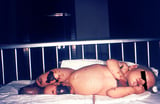 , Rocky Mountain spotted fever Rocky Mountain Spotted Fever (RMSF) Rocky Mountain spotted fever (RMSF) is acquired by Rickettsia rickettsii and transmitted by ixodid ticks. Symptoms are high fever, severe headache, and rash. (See as well Overview of Rickettsial... read more
, Rocky Mountain spotted fever Rocky Mountain Spotted Fever (RMSF) Rocky Mountain spotted fever (RMSF) is acquired by Rickettsia rickettsii and transmitted by ixodid ticks. Symptoms are high fever, severe headache, and rash. (See as well Overview of Rickettsial... read more  (particularly if the palms or soles are involved), or, less normally, some viral infections (eg, dengue fever Dengue Dengue is a mosquito-borne disease caused by a flavivirus. Dengue fever usually results in abrupt onset of high fever, headache, myalgias, arthralgias, and generalized lymphadenopathy, followed... read more , hemorrhagic fevers). Other suggestive skin lesions include the classic erythema migrans rash of Lyme disease Lyme Disease Lyme disease is a tick-transmitted infection caused by the spirochete Borrelia species. Early symptoms include an erythema migrans rash, which may be followed weeks to months afterward by... read more
(particularly if the palms or soles are involved), or, less normally, some viral infections (eg, dengue fever Dengue Dengue is a mosquito-borne disease caused by a flavivirus. Dengue fever usually results in abrupt onset of high fever, headache, myalgias, arthralgias, and generalized lymphadenopathy, followed... read more , hemorrhagic fevers). Other suggestive skin lesions include the classic erythema migrans rash of Lyme disease Lyme Disease Lyme disease is a tick-transmitted infection caused by the spirochete Borrelia species. Early symptoms include an erythema migrans rash, which may be followed weeks to months afterward by... read more 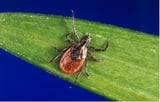 , target lesions of Stevens-Johnson syndrome Stevens-Johnson Syndrome (SJS) and Toxic Epidermal Necrolysis (TEN) Stevens-Johnson syndrome and toxic epidermal necrolysis are severe cutaneous hypersensitivity reactions. Drugs, particularly sulfa drugs, antiseizure drugs, and antibiotics, are the about common... read more
, target lesions of Stevens-Johnson syndrome Stevens-Johnson Syndrome (SJS) and Toxic Epidermal Necrolysis (TEN) Stevens-Johnson syndrome and toxic epidermal necrolysis are severe cutaneous hypersensitivity reactions. Drugs, particularly sulfa drugs, antiseizure drugs, and antibiotics, are the about common... read more 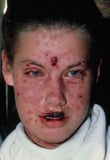 , and the painful, tender erythema of cellulitis Cellulitis Cellulitis is astute bacterial infection of the skin and subcutaneous tissue most oft acquired past streptococci or staphylococci. Symptoms and signs are pain, warmth, rapidly spreading erythema... read more
, and the painful, tender erythema of cellulitis Cellulitis Cellulitis is astute bacterial infection of the skin and subcutaneous tissue most oft acquired past streptococci or staphylococci. Symptoms and signs are pain, warmth, rapidly spreading erythema... read more  and other bacterial soft-tissue infections. The possibility of delayed drug hypersensitivity Drug Eruptions and Reactions Drugs can crusade multiple skin eruptions and reactions. The nigh serious of these are discussed elsewhere in THE Manual and include Stevens-Johnson syndrome and toxic epidermal necrolysis, hypersensitivity... read more
and other bacterial soft-tissue infections. The possibility of delayed drug hypersensitivity Drug Eruptions and Reactions Drugs can crusade multiple skin eruptions and reactions. The nigh serious of these are discussed elsewhere in THE Manual and include Stevens-Johnson syndrome and toxic epidermal necrolysis, hypersensitivity... read more 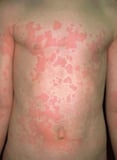 (fifty-fifty after long periods of use) should exist kept in mind.
(fifty-fifty after long periods of use) should exist kept in mind.
If no localizing findings are present, healthy people with astute fever and merely nonspecific findings (eg, malaise, generalized aches) most probable accept a cocky-express viral illness, unless a history of exposure to infected contacts (including a new, unprotected sexual contact), to affliction vectors, or in an endemic area (including recent travel) suggests otherwise.
Patients with significant underlying disorders are more than likely to accept an occult bacterial or parasitic infection. Injection drug users and patients with a prosthetic center valve may have endocarditis. Immunocompromised patients are predisposed to infection caused by certain microorganisms (run across Tabular array: Some Causes of Acute Fever Some Causes of Astute Fever ![]() ).
).
Drug fever (with or without rash) is a diagnosis of exclusion, ofttimes requiring a trial of stopping the drug. I difficulty is that if antibiotics are the cause, the disease being treated may too cause fever. Sometimes a clue is that the fever and rash begin later on clinical improvement from the initial infection and without worsening or reappearance of the original symptoms (eg, in a patient being treated for pneumonia, fever reappears without cough, dyspnea, or hypoxia).
Testing depends on whether localized findings are present.
If localizing findings are present, testing is guided by clinical suspicion and findings (run into also elsewhere in THE Manual), every bit for the post-obit:
-
Specific disorders based on exposure (eg, to contacts, to vectors, or in endemic areas): Testing for those disorders, particularly a peripheral blood smear for malaria
If no localizing findings are present in otherwise healthy patients and serious illness is not suspected, patients can usually be observed at home without testing. In virtually, symptoms resolve chop-chop; the few who develop worrisome or localizing symptoms should be reevaluated and tested based on the new findings.
If serious illness is suspected in patients who have no localizing findings, testing is needed. Patients with ruddy flag findings suggesting sepsis require cultures (urine and blood), chest x-ray, and evaluation for metabolic abnormalities with measurement of serum electrolytes, glucose, blood urea nitrogen, creatinine, lactate, and liver enzymes. Consummate blood count is typically done, but sensitivity and specificity for diagnosing serious bacterial infection are low. However, white blood cell (WBC) count is important prognostically for patients who may be immunosuppressed (ie, a low WBC count may exist associated with a poor prognosis). C-reactive poly peptide elevation is a sensitive only nonspecific indicator of sepsis. An elevated procalcitonin level is indicative of a bacterial process but lacks sufficient sensitivity to warrant routine use.
Patients with sure underlying disorders may demand testing even if they have no localizing findings and practise not appear seriously sick. Because of the risk and devastating consequences of endocarditis, febrile injection drug users are ordinarily admitted to the infirmary for serial blood cultures and often echocardiography. Patients taking immunosuppressants require complete blood count; if neutropenia is present, testing is initiated and breast x-ray is done, as are cultures of blood, sputum, urine, stool, and whatever suspicious skin lesions. Because bacteremia and sepsis are frequent causes of fever in patients with neutropenia, empiric broad-spectrum IV antibiotics should be given promptly, without waiting for civilisation results.
Specific causes of fever are treated with anti-infective therapy; empiric anti-infective therapy that is based on the nigh probable anatomic site and the pathogens involved is required when suspicion of serious infection is high.
Whether fever due to infection should be treated with antipyretics is controversial. Experimental testify, but not clinical studies, suggests that fever enhances host defenses.
Fever should probably be treated in certain patients at particular risk, including adults with cardiac or pulmonary insufficiency or with dementia.
Drugs that inhibit brain cyclooxygenase effectively reduce fever:
-
Acetaminophen 650 to thou mg orally every 6 hours
-
Ibuprofen 400 to 600 mg orally every half dozen hours
The daily dose of acetaminophen should non exceed four k to avert toxicity; patients should be warned non to simultaneously have nonprescription cold or flu remedies that comprise acetaminophen. Other nonsteroidal anti-inflammatory drugs (eg, aspirin, naproxen) are too effective antipyretics. Salicylates should not exist used to treat fever in children with viral illnesses because use has been associated with Reye syndrome.
If temperature is ≥ 41° C, other cooling measures (eg, evaporative cooling with tepid water mist, cooling blankets) should also be started.
In frail older adults, infection is less probable to cause fever, and even when elevated by infection, temperature may be lower than the standard definition of fever. Similarly, other inflammatory symptoms, such as focal pain, may be less prominent. Frequently, amending of mental status or decline in daily functioning may be the simply other initial manifestations of pneumonia Overview of Pneumonia Pneumonia is acute inflammation of the lungs caused past infection. Initial diagnosis is usually based on chest x-ray and clinical findings. Causes, symptoms, treatment, preventive measures, and... read more than or urinary tract infection Introduction to Urinary Tract Infections (UTIs) Urinary tract infections (UTIs) can be divided into upper tract infections, which involve the kidneys (pyelonephritis), and lower tract infections, which involve the bladder (cystitis), urethra... read more than .
In spite of their less astringent manifestations of illness, the febrile older adults are significantly more probable to have a serious bacterial illness than are delirious younger adults. Equally in younger adults, the cause is unremarkably a respiratory infection or urinary tract infection, simply in older adults, peel and soft-tissue infections are among the top causes. Older adults with respiratory virus infections such equally influenza Influenza Influenza is a viral respiratory infection causing fever, coryza, cough, headache, and malaise. Mortality is possible during seasonal epidemics, particularly among high-risk patients (eg, those... read more and COVID-19 COVID-19 COVID-xix is an astute, sometimes astringent, respiratory disease acquired by the novel coronavirus SARS-CoV-two. COVID-19 was first reported in late 2019 in Wuhan, Prc and has since spread extensively... read more are likewise more than probable to have serious manifestations.
-
Most fevers in healthy people are due to viral respiratory tract or gastrointestinal infections.
-
Localizing symptoms guide evaluation.
-
In the absenteeism of localizing symptoms, limiting testing to patients who appear seriously or chronically sick can help avert many unnecessary evaluations.
-
Consider underlying chronic disorders, particularly those impairing the allowed system.
Source: https://www.msdmanuals.com/professional/infectious-diseases/biology-of-infectious-disease/fever
0 Response to "Which of the Following Would Most Likely Require a Complete Review of Systems"
Post a Comment